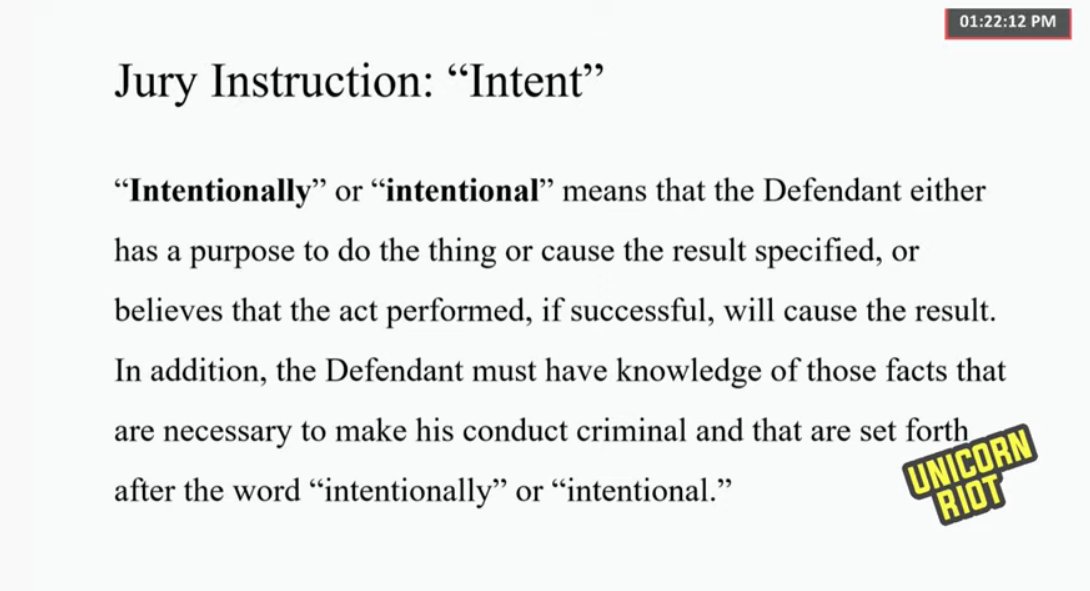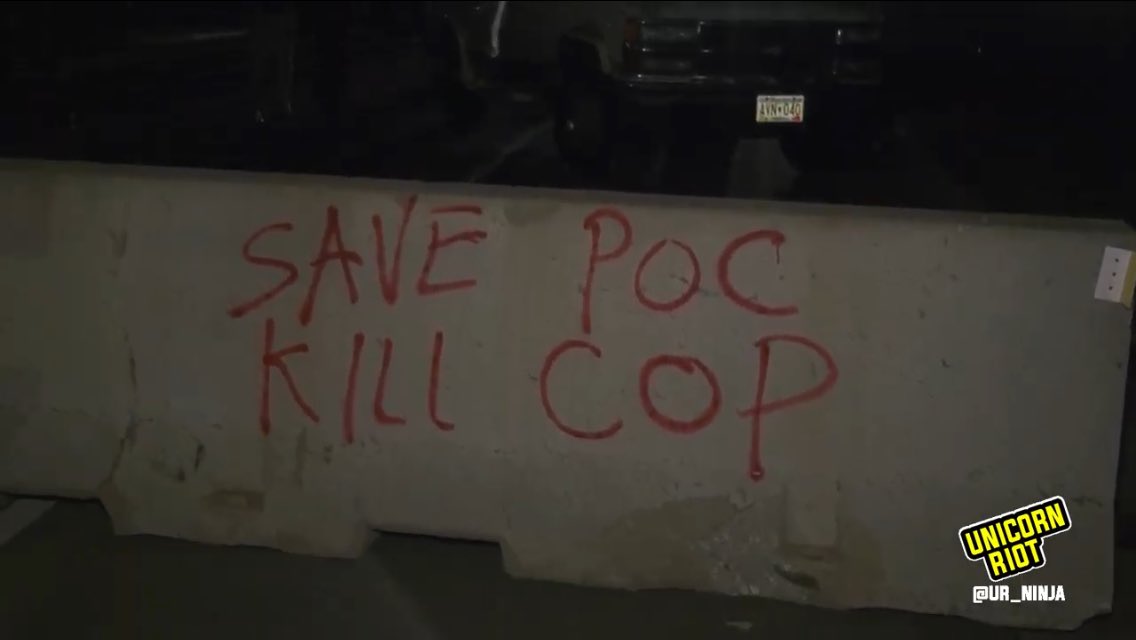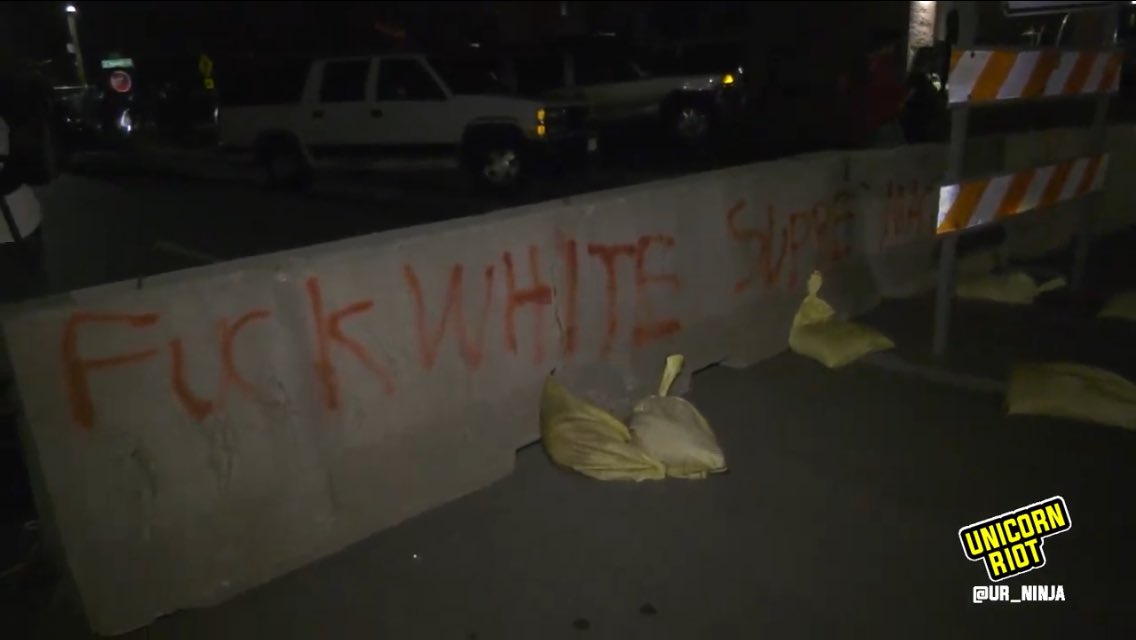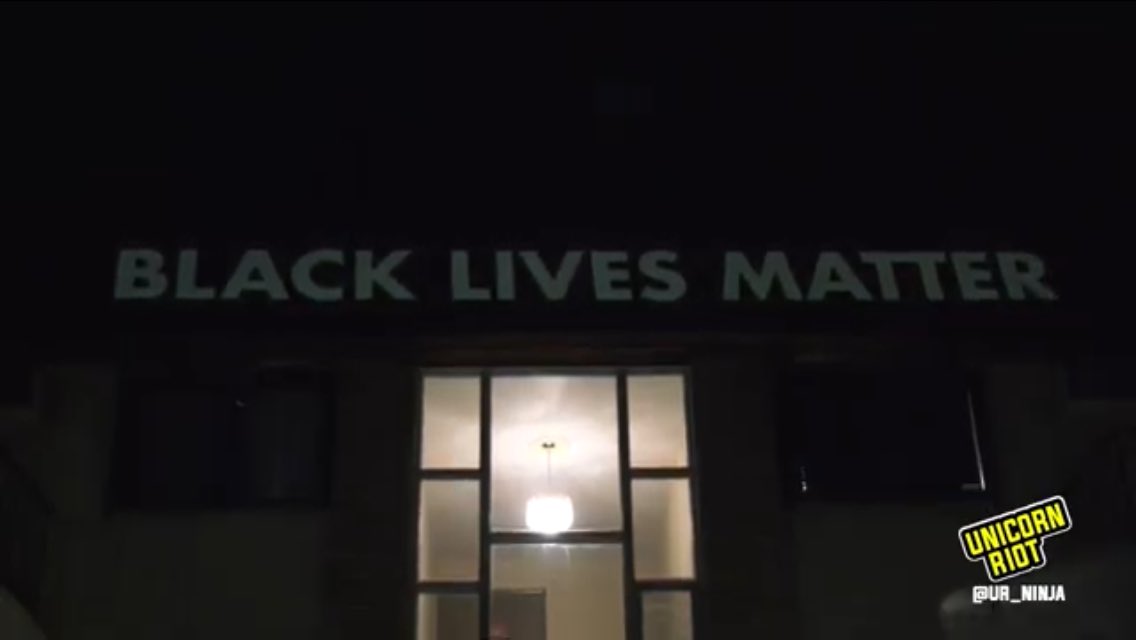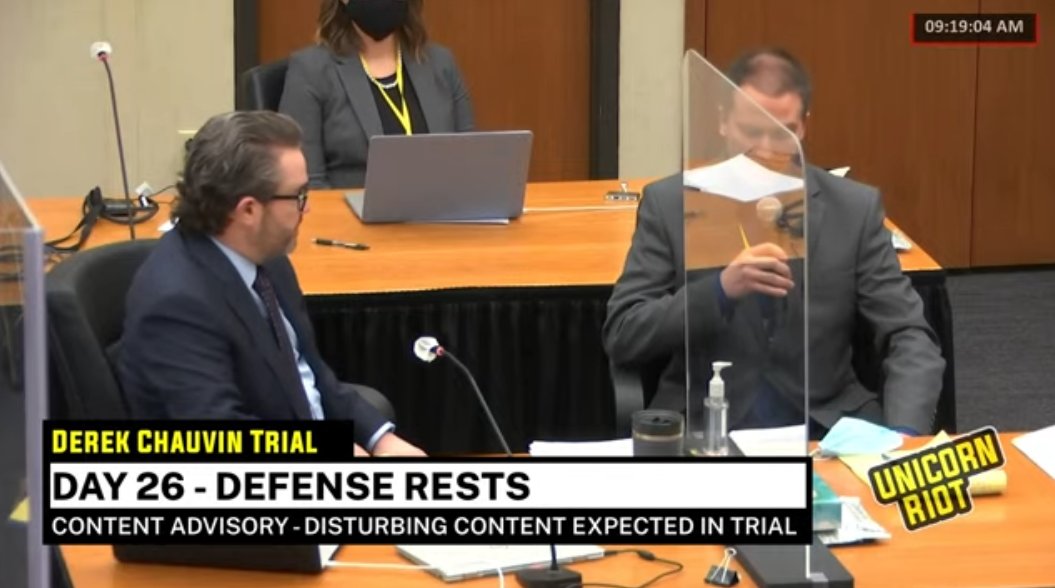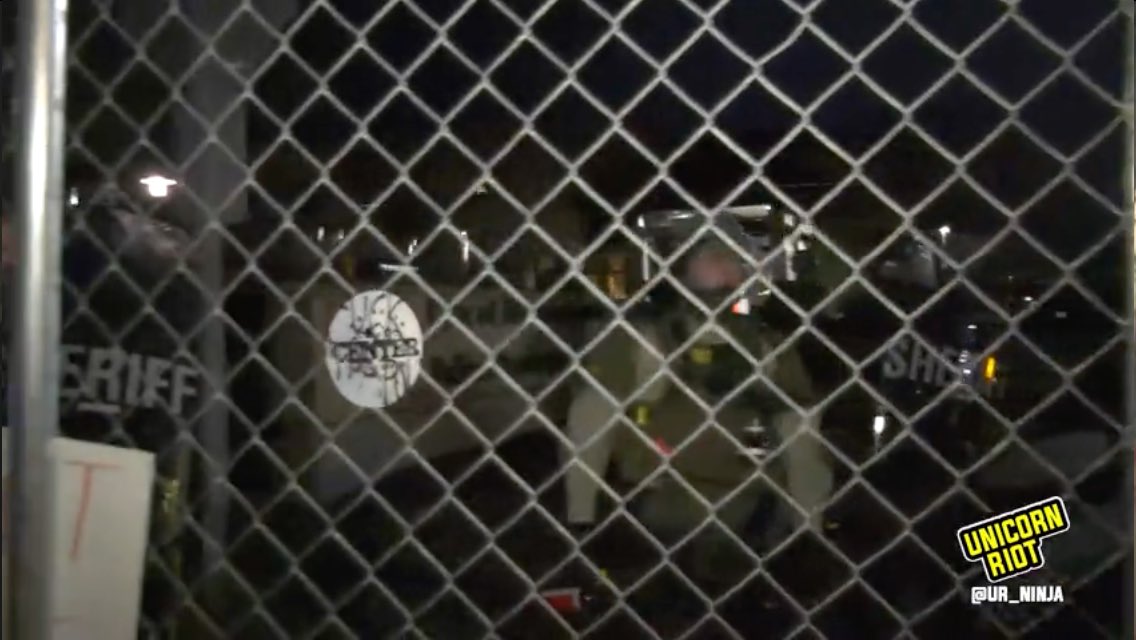
We are #live for the closing arguments in the #DerekChauvinTrial on day 27. Watch our stream here and/or check out our live tweets. twitter.com/i/broadcasts/1…
Court is expected to begin shortly. There is movement in the courtroom, but Judge Cahill is not sitting at his bench yet. Thanks for tuning in.
Judge Cahill just sat down. The jury is in the room. The judge is going to run down the rules of law that the jury must apply.
Each jury member has a packet of the laws for deliberation. The jury can only use the facts that have been presented to them in the court room during the trial.
Judge Cahill defines what proof beyond a reasonable doubt is. He uses a story about a deer crossing a snowy road as an example. Direct evidence is if you see the deer walk across. Circumstantial is if you see the deer's footprints in the snow.
The judge explains what "to cause the death" means--that the defense's actions predominantly caused George Floyd's death. Other causes contributing don't change that criminal liability unless they are superseding causes.
The judge goes over the elements involved in each of the charges against Derek Chauvin. Judge Cahill says each of the elements need to be proved beyond a reasonable doubt. The charges are second-degree unintentional murder, third-degree murder, and second-degree manslaughter.
Judge Cahill says the jury also needs to prove beyond a reasonable doubt that Chauvin acted unreasonably as a police officer and didn't follow the rules and training of the Minneapolis Police Department.
The backend system in the court for the stream went down for a couple minutes. We're back up now.
Schleicher begins closing argument for the prosecution. He begins with "His name was George Perry Floyd Jr."
Schleicher brings up Floyd's mom and the special bond shared between George Floyd and his mom that his brother spoke about on the witness stand.
He zeros in on May 25, 2020. Schleicher says how George Floyd died laying face down on the pavement. He repeats 9 minutes and 29 seconds two times. He says the force was too much--a knee to the neck and a knee to the back. Says 9 minutes and 29 seconds again.
Schleicher says how the pavement lacerated Floyd's face and knuckles as he tried to lift himself to breathe. He says there was no super-human strength that day because there are no super-humans. Schleicher says how George Floyd was a human being.
Schleicher continues to mention 9 minutes and 29 seconds. He mentions how Floyd called Chauvin "Mr. Officer." "Please, I can't breathe" were Floyd's last words and he said those words to Chauvin.
Schleicher says the motto of MPD is to protect with courage and to serve with compassion. He says how George Floyd wasn't a threat to anyone. He says how no courage was required on May 25, but none was shown that day. He also says how no compassion was shown.
"George Floyd begged until he could speak no more and the defendant continued this assault." Schleicher says beyond the point Floyd had a pulse, the defendant continued.
Schleicher reminds the jury that Chauvin didn't get off of Floyd until a paramedic tapped him on the shoulder. Schleicher says the truth is that the defendant was on top of Floyd for 9 minutes and 29 seconds and that Chauvin had to know.
Schleicher says the medical examiner ruled the death as a homicide--killed at the hands of another. Schleicher says how it may be hard for some of the jurors to imagine a police officer committing a crime. "We trust the police." He says how they need to put that aside.
Schleicher says how policing is a most noble profession. This case is not called The State of MN v. The Police. It is a prosecution of the defendant. He mentions that this is a case of a bad police officer.
Schleicher mentions how the MPD Chief of Police Medaria Arradondo testified for the prosecution. How Arradondo shared that they don't train or condone the actions Chauvin took.
Schleicher shares that Nelson said in his opening statement that Chauvin followed the rules, Schleicher asks the jury if they saw proof of that. He says "no" out loud. He says how they heard the Chief of Police say how Chauvin violated the use-of-force policy.
"This was not an accident... He did what he did on purpose, and it killed George Floyd." Schleicher says how Chauvin's actions betrayed the badge. How this prosecution is not an anti-police one, but a pro-police one.
"You can learn a lot about someone by their body language." Schleicher says Chauvin had an ego-based pride that wanted to go against what the by-standers were yelling at him about. Chauvin "chose pride over policing."
One of the by-standers who testified for the prosecution called out to George Floyd on May 25 telling him "you can't win" and Floyd responded saying he wasn't trying to win. Schleicher says how Chauvin was trying to win, and that cost Floyd his life.
Schleicher revisits May 25 before he was interacting with police. How Floyd went into Cup Foods then back to his car and sat in his car. He then hears a knock on his window and turns around and sees a police officer pointing a gun at his face. 

Schleicher goes through the police interaction and how George Floyd complied with their orders. He got out of the car and sat on the curb. He gave them his name and spelled it out. He walked over to the squad car with the officers.
Schleicher explains how Floyd is a large person who has anxiety and claustrophobia. Schleicher plays a clip of the video where the officers try to push him into the back of the squad car, which Schleicher shares is small and may look and feel like a cage to Floyd.
Schleicher says it's nothing new to find a person having a mental health crisis and therefore not complying. How police officers are trained for situations like this. Schleicher says a reasonable police officer should have known what was happening.
Schleicher shows Chauvin's body-worn camera footage from when he first arrived on the scene and officers are trying to shove Floyd in the backseat. Schleicher then plays when they pull Floyd out of the squad car. He mentions how Floyd thanked the officers for pulling him out.
"It could have been over there." Schleicher says Floyd was handcuffed and on his knees. Schleicher says how they push Floyd onto the ground and into the recovery position. Then they take him out of the recovery position and put him in the prone position.
Schleicher brings up how the prone position is supposed to be a transitory position for when an officer needs to handcuff someone; how it's not meant to be used for an extended restraint.
Schleicher asks the jury to use their common sense. He mentions how the jury should follow the judge's rules for the jury instructions in deliberating.
Schleicher goes over some of the instructions. He goes over proof beyond a reasonable doubt. He says the state doesn't need to prove beyond no doubt or nonsense. He says the jury isn't expected to believe or accept a witnesses' testimony that is nonsense.
Schleicher says "what you saw happen, happened."
Schleicher goes over the three charges and the elements that are required. He talks about murder in the 2nd degree. He then moves to the 3rd degree charge. Schleicher says the first element was met--George Floyd died.
Second element--that the defendant caused the death. Schleicher says the jury has to find that 9 minutes and 29 seconds of compression was a substantial factor in Floyd's death.
Schleicher says that a sole superseding cause does not exist in this case. He says again: "Believe your eyes."
Schleicher brings up Dr. Tobin's testimony, and the other doctors. He says Dr. Tobin said how Floyd died and the other doctors testified about how he didn't die.
Schleicher says how Dr. Tobin, and even Dr. Fowler, brought up the anoxic seizure that Floyd had and that they saw in the videos.
Schleicher says how the position Floyd was put in cut off his oxygen and how any normal person would have been cut off from oxygen in that same position. "It was like he was in a vice."
Dr. Tobin's opinion corroborates the police training--there's a danger in the prone position; the worst thing that can happen is positional asphyxia leading to death.
"We heard from Dr. Rich who treats people with heart problems." Schleicher says how Dr. Rich said there was no evidence of a heart attack.
Schleicher brings up the drug level from the toxicology report. "There's no point in talking about those," Schleicher references the drugs found in the squad car. Schleicher reminds the jury how the levels in Floyd were low.
"This looked nothing like a fatal fentanyl overdose." Schleicher says Dr. Tobin testified that Floyd's breathing didn't slow down from fentanyl.
"Impervious to pain? Nonsense!" Schleicher says again how there are no super-humans.
Schleicher brings up how the defense argued that the car killed Floyd. He mentions Dr. Tobin's rebuttal testimony how the maximum CO level in Floyd's blood could have been 2%, which is normal.
Schleicher says how there were multiple moments in time that could have saved Floyd's life--putting him in the recovery position and doing CPR.
"These actions were a substantial factor in George Floyd's death." Schleicher says if the jury finds Chauvin guilty of assaulting Floyd and of causing bodily harm, then they would find him guilty of murder.
"When you hear someone gasping for breath and calling for their mother.." Schleicher asks what else could Chauvin think was happening? He plays a video of Floyd on the ground saying he can't breathe.
Assault in the 3rd degree is substantial bodily harm. Schleicher lists off what counts as substantial bodily harm. He brings up the 2nd degree felony murder charge and explains how Chauvin is guilty.
Schleicher says 3rd degree murder is an act that is imminently dangerous with a disregard for human life. The state must prove that the act was highly likely to cause death and that the defendant was consciously indifferent to human life.
The defendant knew the risks of positional asphyxia in the prone position. Schleicher plays a video of Thao's body-worn camera of by-standers saying Floyd can't breathe and begging Chauvin to get off.
Schleicher then plays a video of one of the other officers suggesting they role Floyd on his side. Chauvin declined and said he was keeping Floyd where they got him.
Schleicher then plays a video of Floyd complaining about pain and not being able to breathe and Chauvin responding with "uh huh" over and over. Schleicher explains how that is indifference.
Schleicher goes back to the charges and elements. He says "you will find that the state has proved guilt in the 3rd degree charge."
Schleicher repeats that the state doesn't have to prove intent.
"Would an ordinary and reasonably prudent person know this was dangerous?" Schleicher says yes, even a 9-year-old by-stander knew it was bad.
Schleicher says Chauvin "knew better, he didn't do better."
After finding Chauvin guilty of all the charges, Schleicher says the jury then needs to find if the actions taken were in-line with what a reasonable police officer would have done.
Schleicher says how the jury needs to reject the testimony of the defense's use-of-force witness who said the position and restraint Floyd was in wouldn't have caused pain.
Schleicher plays a video of Chauvin explaining to McMillan, one of the by-standers, why he was restraining him--Floyd was big and may be on something. Schleicher says everyone is a risk, but not everyone is a threat.
Schleicher says Chauvin's explanation was not good enough and it was not part of procedure. He says how the jury needs to focus on what happened, not on hypotheticals.
Schleicher has been looking directly at the jury during his closing statement. He mentions the hobble and how the officers didn't put Floyd in that position because they'd have to call their supervisor. 

Schleicher says even passive noncompliance didn't happen on May 25.
Schleicher says how the defense argued that the by-standers were distracting. Schleicher says that is not justification for an assault, for murder.
"Officer after officer after officer raised their hand and told you, the Chief of Police" said Chauvin's actions were not procedure and that the force was unreasonable.
"The experts agree because the force has to be reasonable when it starts and when it ends." Schleicher says Floyd said he couldn't breathe 27 times in the first 4 minutes of the restraint.
"How can you justify the continued restraint of this man when there is no pulse?" Schleicher asks "what's the goal?"
Schleicher reminds the jury how the police response was over an alleged counterfeit $20 bill.
"This is not a justified use-of-force." Schleicher goes back to talking about George Floyd's life and how he was always surrounded by people who loved him and who he loved, but how at his death he didn't know any of the by-standers.
Schleicher says even though the by-standers didn't know Floyd, they cared about him and his life. Schleicher says how they were there by fate and they recorded and did what they could. He then says how the jury are also random and by fate.
Schleicher says how the power to convict is the people's power.
Schleicher says what happened on May 25, 2020 and what the jury saw with their eyes and felt in their gut when watching the videos for the first time is what they now feel in their hearts. Schleicher continues to remind the jury to believe in what their eyes saw.
Schleicher is done with his long closing statement. There is now a 20-minute break. The defense's closing statement will be after the break. Thanks for tuning in.
Court is back. Nelson begins his closing statement.
Nelson starts off with thanking the jury. He then says he has a lot to talk about and may be long-winded.
Nelson highlights the presumption of innocence. He says how the defendant doesn't have to prove innocence.
Nelson also highlights proof beyond a reasonable doubt. He says the law recognizes three standards of proof.
He talks about the preponderance of evidence, or the grain of sand that tips the scale.
Then he moves to the clear and convincing evidence. He says this is the standard of proof that the state has to prove to take away your children. The proof beyond a reasonable doubt is the highest standard of proof in the country.
Nelson uses a hypothetical that aliens came down and took over Chauvin's body, and how that's fanciful.
Nelson reminds the jury of "the importance of reading the entire instruction."
Nelson talks about how the jury needs to review all of the evidence in deliberation. He asks the jury to take their time.
Nelson says lawyers need to be intellectually honest when presenting the evidence. Nelson brings up Dr. Fowler's testimony about the potential of CO. Nelson then says he could argue that Floyd didn't die of asphyxia because his blood was saturated with 98% oxygen.
He says he couldn't do that, though, because that argument wouldn't be intellectually honest. Nelson says you need to look at all the evidence and testimony and test it against itself.
Nelson says the state has not proved beyond a reasonable doubt. He now explains a hypothetical to explain the charges against his client.
"A criminal case is kind of like baking chocolate chip cookies." Nelson says that's the analogy he uses with his clients.
Nelson says if the state is missing any one single element, there's a not-guilty verdict.
There are two elements that Nelson wants to focus on in his closing argument. The first element is if the force was reasonable. The second element is the cause of death.
Nelson brings up his opening statement when he spoke about common sense and the reasonable standard. He says the standard is not what the officer should have done, but when considering the totality of the circumstances, what would have a reasonable police officer done?
"There are things a police officer is entitled to take into consideration above the facts." Nelson says a fact that a reasonable officer would know is the type of neighborhood--high crime or not?
He says that police officers consider things that the jury would not even know about. Nelson says a reasonable officer wants to keep his fellow officers safe, wants to keep by-standers safe, they take into account the safety of the person they're arresting.
Nelson says they get information from dispatch, whether the suspect is under the influence of a controlled substance, a reasonable police officer tries to predict future behavior based off of past behavior.
Nelson says it's dynamic and fluid. A reasonable police officer would take into consideration what kind of police officers are on the scene with them.
Nelson says it's not proper to focus only on the 9 minutes and 29 seconds, but that you need to focus on the totality of the circumstances.
Nelson shares a picture of what the officers received from dispatch before arriving on May 25, 2020. 

Nelson mentions Jenna Scurry, who was the 911 operator, and who was a prosecution witness. He brings up the different codes and different dispatches.
Nelson shows body-worn camera footage of ex-Officers King and Lane arriving on the scene on May 25, 2020. Scurry heard a commotion and called for back-up for King and Lane.
Nelson showed body-worn camera footage from Officer Chang who was standing by Floyd's vehicle with the two passengers of Floyd's car. Chang told Chauvin and Thao once they arrived on the scene to go toward squad car 320.
Nelson shows the MPD use-of-force definitions sheet that describes the difference between active aggression and active resistance. Nelson says a reasonable police officer arriving on the scene would observe what was happening. Nelson says Chauvin did that. 

Nelson says Chauvin didn't touch Floyd until he was out of squad car 320. Nelson shows the MPD Defense & Control Response Training Guide. Nelson says Chauvin was justified in either doing a distraction technique, controlled take-down, or a conscious neck restraint. 


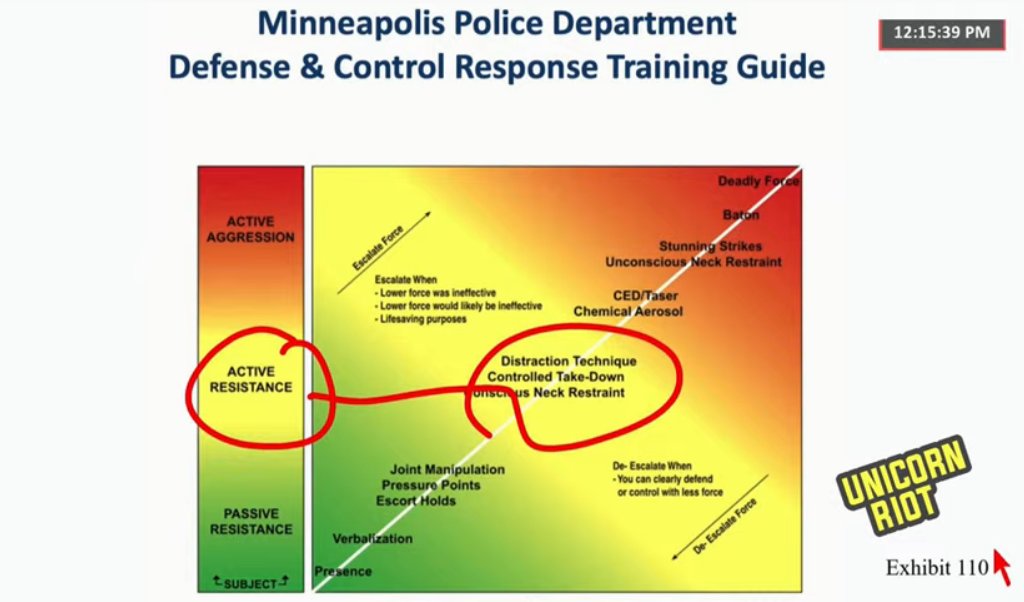
Nelson says Chauvin observed that the force being used by King and Lane was not sufficient.
"A reasonable police officer would be feeling a surge of adrenaline." Nelson shows body-worn camera footage from ex-Officer King, Lane, and Thao of when he is pulled out of squad car 320. Chauvin helps pull Floyd out of the squad car.
"A reasonable officer understands the intensity of the struggle." Nelson argues that Floyd was able to overcome the force of three officers.
Nelson shows the Milestone city camera and asks the jury to watch the squad car move back-and-forth. Dispatcher Scurry called the officer's supervisor when she saw the car moving.
Nelson brings up that no use-of-force experts or officers said in their testimony that the actions up until Floyd was on the ground were unjustified or unreasonable.
Nelson says now is when the 9 minutes and 29 seconds begins when Floyd is on the ground. Nelson reiterates that only focusing on this part is not a proper case because it ignores the previous 16 minutes.
Nelson says police officers know human behavior very well because one minute they can comply and the next minute they can resist.
Nelson shows the first 20 seconds of Floyd on the ground. He explains how Floyd is resisting, and how reasonable officers would consider increasing the use-of-force.
Nelson explains how reasonable police officers talk amongst themselves and consider what to do next. Nelson says the officers were talking about the possible intoxication and who the two passengers in his car were.
Nelson says how the officers called for EMS and were expecting them to arrive sooner than they did. He also brings up the theory that if you can talk, you can breathe.
Nelson even mentions how Dr. Tobin said that's not a full statement, because it doesn't mean someone can breathe effectively or sufficiently. Yet, Nelson then says if you're talking, you're breathing fine.
Nelson brings up "excited delirium" which one of the officers brought up to Chauvin on May 25. Chauvin responded by saying that's why EMS was coming.
Nelson shows the anoxic seizure that Dr. Tobin testified to. Nelson says a reasonable police officer may not know what an anoxic seizure is and that an officer may see a leg twitch as resistance.
Nelson reads the MPD definition of "Non-Deadly Force" and lightly chuckles while saying that this is the policy, and that Chauvin was following MPD policy. 

Nelson talks about perspective. He talks about how his perspective is cut off in the court room. How he can only see some of the jurors from his seat.
Nelson mentions how he, Chief Arradondo, and Darnella Frazier went to the same high school. How their perspectives were the same (same white boards and classrooms), but probably had different perceptions.
Nelson goes over who the by-standers were. He goes over their potential perceptions.
Nelson says that "we know" the fluid coming from near Floyd was from the squad car.
Nelson says what Genevieve Hansen, the off-duty MPD firefighter who was a by-stander on May 25, testified to is just her perception and her perspective, and it's not corroborated with the facts.
Nelson says that Officer Chauvin, by looking up and down and around, was considering what he was doing and if it was appropriate, which Nelson says is what a reasonable police officer does.
Nelson reads the crisis intervention process out loud. He says a reasonable officer would view the by-standers as in a crisis. 
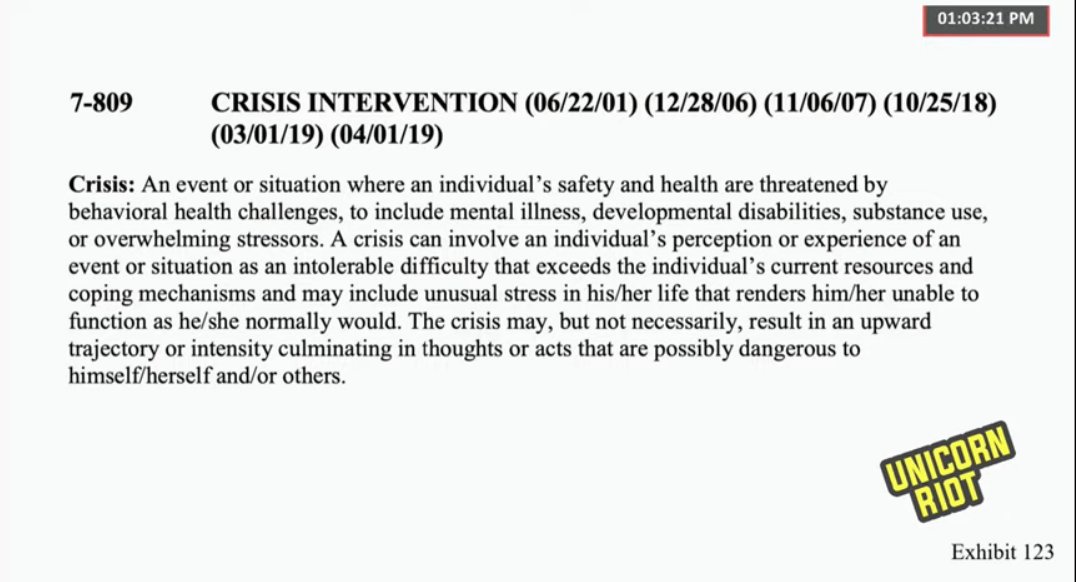
"As this crowd grew more and more upset, and more deep into crisis," Nelson mentions a pivotal moment when Floyd takes his last breath at 8:25:16. Nelson says at that time Chauvin takes his pepper spray out and shakes it at the by-standers and Genevieve Hansen crosses the street.
Nelson blames the crowd for Chauvin not noticing Floyd wasn't breathing. Nelson says you can't do CPR in a dangerous situation.
Nelson brings up the critical decision making model and mentions a witness who testified how an officer needs to decide if it's worth taking handcuffs off to administer first aid.
Nelson plays Officer Chang's body-worn camera of the two passengers of Floyd's car. Nelson says how Chang was moving side-to-side and pacing.
Nelson mentions how different witnesses testified on when unreasonable use-of-force began.
Nelson brings up Lt. Johnny Mercil's testimony. He helped train Chauvin. Nelson says Mercil testified that it is routinely trained to put a knee on the base of someone's neck.
Nelson says he knows that super-human strength isn't real, but that police are trained if someone is on certain drugs, they can have more strength than they usually would. He then uses an example: "A woman who is pregnant who can lift a car off of someone."
Nelson says Mercil testified how sometimes you don't want to put someone in the recovery position. "The use-of-force is an incredibly complicated analysis."
Nelson says Chauvin's actions were a reasonable use-of-force and therefore, there is reasonable doubt.
Concept of intent. Nelson says play close attention to the instructions.
Nelson goes through body-worn camera footage again of when officers try to put Floyd in the squad car and when they pull him out. Nelson says Chauvin's actions don't prove intent to harm.
Nelson says Chauvin isn't swearing at Floyd or calling him names.
Nelson says the circumstances and evidence show that Chauvin did not purposefully use unlawful force. Nelson says "these are officers doing their job in a highly stressful situation." He says "it's tragic."
"People sleep in the prone position, people sunbathe in the prone position, people get massages in the prone position."
Nelson says how the prone position is not inherently dangerous. He says if someone is restrained in the prone position, or there's weight on the person, it's still not inherently dangerous.
Nelson moves onto the second part of his closing statement: cause of death. Nelson has been speaking for 2 hours so far.
Nelson uses an example of someone being arrested, put in a squad car in the summer, the windows are closed and the heat is turned on, and the person dies. He says it's the natural consequence/result of being arrested.
Nelson says if someone was arrested and placed in a squad car without those circumstances, and the person had a heart attack, then it's not the natural result of the actions of the officer.
Nelson says that the state has to convince the jury that Floyd's heart disease, high blood pressure, paraganglioma, toxicology, or any other possible contributing factors are not substantial beyond a reasonable doubt.
Nelson says Dr. Tobin said Floyd died exclusively from positional asphyxia. He brings up the hospital physician Dr. Smock who said he didn't notice any heart conditions playing into Floyd's death.
Nelson goes through the other medical witnesses who testified that no other preexisting and coexisting conditions contributed to Floyd's death. Nelson says their testimonies fly in the face of common sense.
Nelson lightly chuckles when saying how the cardiologist Dr. Rich testified that Floyd's heart didn't contribute to his death.
Nelson then brings up Dr. Baker's testimony. He reminds the jury that there weren't injuries to the neck or spinal column found in the autopsy.
Nelson continues to talk about manners and causes of death. He brings up the medical definition of homicide. 

He explains the definition of "complicated" as written and then defined by Dr. Baker. "An unexpected result."
Nelson says Dr. Baker testified that if you put something on the autopsy, that it's important.
Nelson says how Dr. Baker defined Floyd's death as a multi-factoral death. How Floyd's heart couldn't take it.
Nelson says how not one factor was more substantial than another. However, on the top line of the autopsy is the immediate cause of death, which Dr. Baker put "Cardiopulmonary arrest complicating law enforcement subdual, restraint, and neck compression." 

Nelson shows body-worn camera footage of Floyd on the ground with the officers on top of him. Nelson asks "what do you see?" Nelson says Floyd is on his side in the recovery position.
Nelson brings up the lifting of Chauvin's foot and how one witness testified how that was putting a lot of weight on Floyd. Nelson plays a video that shows "dynamic shifting." "You cannot take a single frame and draw conclusions. You have to look at the totality."
Nelson brings up the toxicology. Nelson says how Floyd's drug-use is important because it can help show how his body reacts.
"We know that on May 6, 2019, that Floyd ingested controlled substances..." Nelson brings up his high blood pressure on that day.
Nelson says how Floyd's ex-girlfriend testified that Floyd was sober for a little while when he was quarantining while Covid-19 positive.
Nelson brings up how Floyd may have fallen asleep a little bit after leaving Cup Foods when in his car.
"We know that there were pills in the car." Nelson says "it's relevant because it's what was in his system."
Nelson says because pills were found in a squad car with Floyd's saliva, that means he must have had them in his mouth before being arrested.
Nelson shows a picture showing the small amount of fentanyl that can kill someone.
Nelson says the medical experts minimized the drug use and Floyd's toxicology.
Nelson says how methamphetamine can be a vasoconstrictor.
Nelson thinks it's "preposterous" that the state's medical witnesses didn't consider thoroughly enough that Floyd's drug use could be the cause of death. "Every single doctor just brushed it aside."
Judge Cahill interrupts Nelson to give the jury a 30-minute lunch break. Nelson's closing statement has been about 3 hours so far. Court will be back in 24 minutes.
Court is back. Nelson continues his closing statement.
Nelson says "this death needs to be looked at." He says to simply come in and say a combination of substances, and with "blockages in the heart," to just "poo poo" it is a preposterous notion.
Nelson says the state has gone to "great lengths" to overlook Floyd's heart problems.
Nelson talks about adrenaline, and also brings up potential adrenaline secretion from the paraganglioma.
Nelson brings up how Dr. Tobin ascribes the cause of death to brain hypoxia. Nelson says Dr. Fowler ascribed hypoxia to the heart.
Nelson says Floyd's actions prove he died of a sudden cardiac arrhythmia. Nelson believes Floyd had enough oxygen in his brain because he was speaking, so from the time he stopped speaking until he stopped moving, Nelson says that's about 1 minute.
Nelson says "we don't know" how CO is involved, but what "we do know" is that the car was running.
Nelson's last point is about the superseding cause.
"Let's look at the medical timeline here." Nelson goes over when EMS was called and when they arrived.
Nelson says the first air is pumped into Floyd 10 minutes after he went unconscious, which Nelson says Dr. Tobin said. Nelson then suggests the paramedics could have started CPR right when they got to the scene and maybe that would have made a difference.
Nelson reassures the jury that he's not blaming the paramedics, but that their delay could have contributed to Floyd not being successfully resuscitated.
Nelson says that the state has failed to prove its case beyond a reasonable doubt. Nelson has finished.
The state has a motion. The jury is not present. The state brings up that Nelson talked about how Chauvin didn't have intent, but Schleicher says since the state doesn't have to prove intent, he wanted Judge Cahill to read a curative instruction.
Judge Cahill denies the request, but says he'll re-read a part of his instructions to reiterate that the state doesn't have to prove intent.
The jury is back brought in. Nelson wants to say something, but Judge Cahill cut him off because the jury walked in.
Judge Cahill re-reads part of the jury instructions. Jerry Blackwell starts to do the rebuttal statement.
Jerry Blackwell mentions the 46th witness, which is the jury members' common sense.
Blackwell asks why it was necessary to continue to apply deadly force on someone who is not resisting. He reminds the jury to believe their eyes just as Schleicher did.
Blackwell brings up the totality of the circumstances and how reaching a verdict--reaching the truth--means the jury needs to decipher the stories told to them from the truth.
Blackwell brings up how the studies Nelson brought up in his closing statement weren't of someone kneeling on someone's neck, which Blackwell and the other prosecution attorney's argued and showed with their witnesses.
Blackwell brings up when Nelson said the "complicating" part of Dr. Baker's autopsy meant it was an unexpected outcome. Blackwell says Dr. Baker didn't say that and that Nelson is putting words in his mouth.
Blackwell corrects Nelson's explanation of the law in his closing statement. How Nelson said that there can only be the one proven factor beyond a reasonable doubt--Blackwell says there can be multiple factors.
Blackwell says that Nelson was arguing that it's coincidence that Floyd was in a subdual neck restraint when he died from heart failure or from an overdose or from the many reasons Nelson spoke about.
Blackwell shows a diagram showing one blue dot for every single day George Floyd was alive. The circle of dots shows the increments of time on May 25, 2020. Blackwell explains how all that time he didn't die from his preexisting or coexisting conditions. 



Blackwell says ultimately both the heart and breathing stopped in Floyd on May 25, 2020 and that directly stemmed from the subdual neck restraint.
Blackwell explains how Chauvin had all of the power on May 25. He had the bullets, the mace, the badge, the back-up, etc.
Blackwell says how the jury has heard about the by-standers from Nelson. Blackwell explains how the by-standers felt torn between the sanctity of life and their respect for law enforcement.
"They didn't deserve to be called unruly." Blackwell believes the by-standers were defenseless, helpless, and upset.
"There can be no excuse for police abuse." Blackwell says Nelson has been using excuses such as the traffic distracting the officers. 911 Dispatcher Scurry was watching the live city video and noticed the officers on top of Floyd for so long she thought the cam froze.
Scurry didn't think the officers looked distracted and they didn't move off of the street away from traffic.
Blackwell says even though Nelson said the car was on in his closing statement, the defense didn't have a witness on the stand testifying to that.
"In your custody is in your care." Blackwell says well if CO was a contributing factor, then whose car is that? He says how putting someone near the tail pipe of a running vehicle is not something a reasonable police officer would do.
Blackwell brings up the toxicology and says "what meth?" He explains that the levels were so low that it's not worth bringing up.
"You don't need a PHD, an MD, to know how fundamental breathing is to life." Blackwell says even the 9-year-old girl by-stander knew something wasn't right. She said on the witness stand how she wanted to call 911 on the police. 

Blackwell brings up Nelson's argument that Floyd could have been resuscitated and then pose a threat. Blackwell says the thought that Floyd could have broken out of the handcuffs and rampaged the city after not having a pulse, is from a halloween movie, not real life.
"The fact of the matter is, ladies and gentlemen, that the unreasonable use of force is an assault."
Blackwell says there really aren't two sides of the story of the reasonableness of use-of-force in this case. Blackwell suggests there is just one side, which is the use-of-force was unreasonable.
Blackwell finishes off his closing statement by saying Floyd didn't die because his heart was too big, which is something the defense kept arguing, but that Chauvin's heart was too small.
Blackwell is done with his rebuttal. Closing statements are over. Judge Cahill reads more jury instructions.
He reminds the jury how the verdict must be unanimous.
The jury is reminded that they must not let bias, opinion, passion, or outside influences affect their decision. Also that if they don't like a witness or attorney, that can't affect their decision either.
Judge Cahill has a deputy swear to keep the jury members all together and make sure no one contacts them and for the deputy not to hear any of the deliberations.
The jury is excused. Nelson says the prosecution was belittling the defense and saying the defense was misrepresenting facts. Nelson says a mistrial should be considered. Nelson has asked for a mistrial at least a few times since the trial began.
Judge Cahill says he sustained objections that Nelson made, and he believes that's adequate. Judge Cahill is not going to move forward with a mistrial.
Nelson also brings up that a congress person mentioned that if a guilty verdict does not happen, there will be problems. Nelson thinks if any of the jury members saw that, it could sway them. Nelson says that the media pervasiveness may prevent a purely unbiased jury.
Judge Cahill says that Nelson may be able to use what Congresswoman Maxine Waters said in an appeal, but that it's not cause for a mistrial.
Nelson asks about objections because for any potential appeal, the attorney's can use any objections and the judge's ruling in their appeal.
The state is seeking an aggravated sentence be imposed. Nelson is now speaking to Chauvin about this and Nelson says how a jury can be involved. Chauvin doesn't want a jury to decide, he wants Judge Cahill to. 

Judge Cahill just said court is in recess until "we hear from the jury." Deliberation for today will happen until 7 p.m. central time. Then it will continue tomorrow and so on until they come to a unanimous decision.
Thanks for tuning in to our coverage. We appreciate everyone who has been trusting and supporting us through our coverage of this trial and beyond. Check out our trial coverage page for more info: unicornriot.ninja/derek-chauvin-…
• • •
Missing some Tweet in this thread? You can try to
force a refresh




